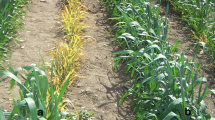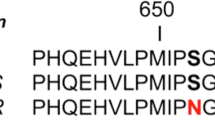Abstract
Background and aims
In this study, we describe the molecular, physiological and agronomic aspects involved in the resistance to acetyl coenzyme A carboxylase inhibiting herbicides (ACCase) observed in one biotype of Phalaris paradoxa from Mexico.
Methods
Dose–response Assays: The herbicide rate inhibiting plant growth of each biotype by 50% with respect to the untreated control, ED50. Enzyme purification and ACCase assays to determine herbicide rate inhibiting the enzyme of each biotype by 50% with respect to the untreated control, I50. Absorption and Translocation Assays with [14C]diclofop-methyl. Metabolism of diclofop-methyl and its metabolites were identified by thin-layer chromatography. Study of target site resistance mechanism at enzyme and molecular levels.
Results
In this work, it has been studied the whole-plant response of Phalaris paradoxa biotypes from Mexico resistant (R) and susceptible (S) to ACCase-inhibiting herbicides: aryloxyphenoxypropionate (APP), cyclohexanedione (CHD) and phenylpyrazoline (PPZ), and the mechanism behind their resistance were studied. To analyse the resistance mechanism, the enzyme ACCase activity was investigated. Results from biochemical assays indicated a target-site resistance as the cause of reduced susceptibility to ACCase inhibitors. The absorption, translocation and metabolism were similar between R and S biotypes. A point mutation never described before was detected within the triplet of glycine at the amino acid position 2096 (referring to EMBL accession no. AJ310767) and resulted in the triplet of serine. This new mutation could explain the loss of affinity for the ACCase-inhibiting herbicides.
Conclusions
We found a new mutation, which had never been described before. This mutation was detected within the triplet of glycine at the amino acid position 2096. This new mutation confers cross-resistance to three different chemical groups of ACCase-inhibiting herbicides.



Similar content being viewed by others
References
Christoffers MJ, Pederson SN (2007) Response of wild oat (Avena fatua) acetyl-coA carboxylase mutants to pinoxaden. Weed Sci. Soc. Am. Abstr, No, 256
Collavo A, Panozzo S, Lucchesi G, Scarabel L, Sattin M (2011) Characterisation and management of Phalaris paradoxa resistant to ACCase-inhibitors. Crop Prot 30:293–299
Cruz-Hipolito H (2010) Gramíneas resistentes a herbicidas en Latinoamérica: Aspectos agronómicos, bioquímicos y moleculares. PhD Dissertation, University of Cordoba, Spain
Cruz-Hipolito H, Osuna MD, Domínguez-Valenzuela J, Espinoza N, De Prado R (2011) Mechanism of resistance to ACCase-inhibiting herbicides in wild oat (Avena fatua) from Latin America. J Agric Food Chem 59:7261–7267
Dellow JJ, Milne BR (1986) Control of Phalaris paradoxa in wheat. Australian Weeds 3:22–23
De Prado R, Franco AR (2004) Cross-resistance and herbicide metabolism in grass weeds in Europe: biochemical and physiological aspects. Weed Sci 52:115–120
De Prado JL, Osuna MD, Heredia A, De Prado R (2005) Lolium rigidum, a pool of resistance mechanisms to ACCase inhibitor herbicides J. Agric Food Chem 2005(53):2185–2191
Délye C, Calmès É, Matéjicek A (2002) SNP markers for black-grass (Alopecurus myosuroides Huds.) genotypes resistant to acetyl CoAcarboxylase inhibiting herbicides. Theor Appl Genet 104:1114–1120
Délye C (2005) Weed resistance to acetyl coenzyme A carboxylase inhibitors: an update. Weed Sci 53:728–46
Délye C, Pernin F, Michel S (2011) ‘Universal’ PCR assays detecting mutations in acetyl-coenzyme A carboxylase or acetolactate synthase that endow herbicide resistance in grass weeds. Weed Res 51:353–362
Devine MD, Macisaac SA, Romano ML, Hall JC (1992) Investigation of the Mechanism of Diclofop Resistance in 2 Biotypes of Avena-fatua. Pestic Biochem Physiol 42:88–96
Devine MD, Hall JC, Romano ML, Marles MAS, Thomson LW, Shimabukuro RH (1993) Diclofop and fenoxaprop resistance in wild oat is associated with an altered effect on the plasma membrane electrogenic potential. Pestic Biochem Physiol 45:167–177
Devine MD, Shimabukuro RH (1994) Resistance to acetyl coenzyme A carboxylase inhibiting herbicides. In: Herbicide Resistance in Plants. Biology and Biochemistry; Powles SB, Holtum JAM, Eds.; Lewis Publishers: Boca Raton, FL, 1994; pp 141–169
Evenson KJ, Gronwald JW, Wyse DL (1997) Isoforms of acetyl-coenzyme A carboxylase in Lolium multiflorum. Plant Physiol Biochem 35:265–272
Gherekhloo J, Rashed Mohassel MH, Mahalati MN, Zand E, Ghanbari A, Osuna MD, De Prado R (2011) Confirmed resistance to aryloxyphenoxypropionate herbicides in Phalaris minor populations in Iran. Weed Biol Manag 11:29–37
Gronwald JW, Eberlein CV, Betts KJ, Baerg RJ, Ehlke NJ, Wyse DL (1992) Mechanism of diclofop resistance in an Italian ryegrass (Lolium multiflorum Lam.). Pestic Biochem Physiol 44:126–139
Heap I (2011) The international survey of herbicide resistant weeds. Online. Internet. June 03. Available at www.weedscience.com
Heap IM, Murray BG, Loeppky HA, Morrison IN (1993) Resistance to aryloxyphenoxypropionate and cyclohexanedione herbicides in wild oat (Avena fatua). Weed Sci 41:232–238
Heap JW, Knight R (1982) A population of ryegrass tolerant to the herbicide diclofopmethyl. J Aust Ins Agric Sci 48:156–157
Hochberg O, Sibony M, Rubin B (2009) The response of ACCase-resistant Phalaris paradoxa populations involves two different target site mutations. Weed Res 49:37–46
Hofer U, Muehlebach M, Hole S, Zoschke, A (2006) Pinoxaden for broad spectrum grass weed management in cereal crops. J Plant Dis Prot 20:989–995
Holtum JAM, Häusler RE, Devine MD, Powles SB (1994) Recovery of transmembrane potentials in plants resistant to aryloxyphenoxypropanoate herbicides: a phenomenon awaiting explanation. Weed Sci 42:293–301
Kaundun SS (2010) An aspartate to glycine change in the carboxyl transferase domain of acetyl CoA carboxylase and non-target-site mechanism(s) confer resistance to ACCase inhibitor herbicides in a Lolium multiflorum population. Pest Manag Sci 66:1249–1256
Letouze A, Gasquez J (2003) Enhanced activity of several herbicide-degrading enzymes: a suggetsed mechanism responsible for multiple-resistance in blackgrass (Alopecurus myosuroides Huds.). Agronomie 23:601–608
Liebl R, Worsham AD (1987) Effect of chlorsulfuron on the movement and fate of diclofop in Italian ryegrass (Lolium multiflorum) and wheat (Triticum aestivum). Weed Sci 35:623–628
Liu WJ, Harrison DK, Chalupska D, Gornicki P, O’Donnell CC, Adkins SW, Haselkorn R, Williams RR (2007) Single-site mutations in the carboxyltransferase domain of plastid acetyl-CoA carboxylase confer resistance to grass-specific herbicides. Proc Natl Acad Sci USA 104:3627–32
Maneechote C, Preston C, Powles SB (1997) A diclofop-methyl-resistant Avena sterilis biotype with a herbicide-resistant acetyl-coenzyme A carboxylase and enhanced metabolism of diclofop-methyl. Pestic Sci 49(105):114
Martin RJ, Felton WL (1993) Effect of crop rotation, tillage practice, and herbicides on the population dynamics of wild oats in wheat. Aust J Exp Agr 33:159–165
Medina CT (2000) Evaluación de herbicidas sobre alpiste (Phalaris spp.) resistente a herbicidas colectado en la región del Bajío. XXI Congreso Nacional de la Ciencia de la Maleza. Morelia, Mich., México
Menéndez J, De Prado R (1996) Diclofop-methyl cross-resistance in a chlorotoluron-resistant biotype of Alopecurus myosuroides. Pestic Biochem Physiol 56:123–133
Petit C, Bay G, Pernin F, Délye C (2010) Prevalence of cross or multiple resistance to the acetylcoenzyme A carboxylase inhibitors fenoxaprop, clodinafop and pinoxaden in black-grass (Alopecurus myosuroides Huds.) in France. Pest Manag Sci 66:168–77
Powles SB, Yu Q (2010) Evolution in action: plants resistant to herbicides. Annu Rev Plant Biol 61:317–347
Preston C, Tardif FJ, Christopher JT, Powles SB (1996) Multiple resistance to dissimilar herbicide chemistries in a biotype of Lolium rigidum due to enhanced activity of several herbicide degrading enzymes. Pestic Biochem Phys 54:123–134
Scarabel L, Panozzo S, Varotto S, Sattin M (2011) Allelic variation of the ACCase gene and response to ACCase-inhibiting herbicides in pinoxaden target-site resistant Lolium spp. Pest Manag Sci 67:932–941
Seefeldt SS, Fuerst EP, Gealy DR, Shukla A, Irzyk GP, Devine MD (1996) Mechanisms of resistance to diclofop of two wild-oat (Avena fatua) biotypes from the Williamette Valley of Oregon. Weed Sci 44(776):781
Seefeldt S, Jensen J, Fuerst E (1995) Log-logistic analysis of herbicide dose-response relationships. Weed Technol 9:218–227
Shimabukuro RH, Hoffer BL (1991) Metabolism of diclofop-methyl in susceptible and resistant biotypes of Lolium rigidum. Pestic Biochem Physiol 39:251–260
Shimabukuro RH, Hoffer BL (1992) Effect of diclofop on the membrane potentials of herbicide-resistant and susceptible annual ryegrass root tips. Plant Physiol 98:1415–1422
Shukla A, Dupont S, Devine MD (1997) Resistance to ACCase inhibitor herbicides in wild oat: evidence for target site-based resistance in two biotypes from Canada. Pestic Biochem Physiol 57:147–155
Walker S, Robinson G, Medd R, Taylor I (1999) Weed and crop management have a major impact on weed seed bank. In: Proceedings 12th Australian Weeds Conference, Hobart, Australia, 191–194
Walker SR, Medd RW, Robinson GR, Cullis BR (2002) Improved management of Avena ludoviciana and Phalaris paradoxa with more densely sown wheat and less herbicide. Weed Res 42:257–270
Weber E, Gut D (2004) Assessing the risk of potentially invasive plant species in central Europe. J Nat Conservat 12:171–179
White GM, Moss SR, Karp A (2005) Differences in the molecular basis of resistance to the cyclohexanedione herbicide sethoxydim in Lolium multiflorum. Weed Res 45:440–48
Yu Q, Collavo A, Zheng MQ, Owen M, Sattin M, Powles SB (2007) Diversity of acetyl-coenzyme A carboxylase mutations in resistant Lolium populations: evaluation using clethodim. Plant Physiol 145:547–558
Acknowledgments
The authors thank the technical help of Rafael A. Roldán-Gómez. Part of this work has been co-financed by MICINN (AGL2010-16774).
Author information
Authors and Affiliations
Corresponding author
Additional information
Responsible Editor: Hans Lambers.
Rights and permissions
About this article
Cite this article
Cruz-Hipolito, H., Domínguez-Valenzuela, J.A., Osuna, M.D. et al. Resistance mechanism to acetyl coenzyme A carboxylase inhibiting herbicides in Phalaris paradoxa collected in Mexican wheat fields. Plant Soil 355, 121–130 (2012). https://doi.org/10.1007/s11104-011-1085-3
Received:
Accepted:
Published:
Issue Date:
DOI: https://doi.org/10.1007/s11104-011-1085-3




